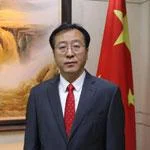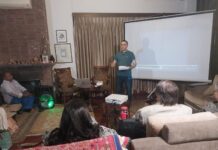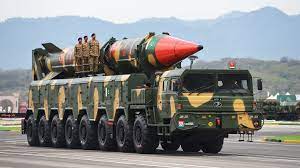The President of the USA himself alleged that Pakistan may be “one of the most dangerous nations in the world” as the country has “nuclear weapons without any cohesion.” What bothers president Biden is the unsubstantiated fear that Pakistani nukes may fall into hands of Islamic fundamentalists. A clue to Biden’s subconscious mind is given by Condoleezza Rice, then Secretary of State-nominee for the junior Bush’s administration during her confirmation hearing before the Senate Foreign Relations Committee. She said that “the United States maintains a contingency plan to prevent Pakistani nuclear weapons from falling into the hands of Islamist fundamentalists if they came to power”.
Rice added that “she could not discuss this publicly although she was willing to brief members of the committee in a private session”.
The USA believes that Pakistan’s nukes have no Permissive Action Links (PALS). So they may go off accidentally. Once a US F16 was accidentally loaded with live nukes. These nukes fell on snow-capped mountains in Spain. But they did not detonate because of PALs, computerised if-then-else conditions that restrict detonation.
After a lull of a few months, Pakistan’s nuclear programme, again and again, comes into negative limelight. The familiar pattern is that a credible-looking stimulus is boisterously responded to by Indian and international media.
Previous examples of such stimuli are the dossier on Pakistan’s nuclear scientist Doctor AQ Khan, or the meeting between Osama bin Laden and nuclear scientist Sultan Bashiruddin Mahmood accompanied by Pakistan Atomic Energy Commission former engineer Abdul Majeed Chaudhry. The thrust of propaganda was that Al-Qaeda could steal radio-active material from Pakistan’s nuclear labs to make ’dirty bombs’, a euphemism for radiological-dispersal devices.
Pakistan itself is much worried about national cohesion. Pakistan’s National Security Policy (2022-26) identified ‘National Cohesion’ as an important pillar of the country’s security architecture. The Policy states ‘ ‘National Cohesion’ is an important prerequisite for an independent and prosperous country.’
Pakistan’s nuke-safety foolproof: The dossier (‘Nuclear Black Markets: Pakistan, A. Q. Khan and the Rise of Proliferation Networks’), in spite of its hostile tenor, expresses satisfaction over the steps taken by Pakistan to safeguard its nuclear assets. It views Dr Qadeer’s activities as the fault of an Individual without connivance or cooperation of the Pak government. Even George Bush, has in a statement, categorically stated that Dr Qadeer’s network was now out of business.
The existing watertight security and safety mechanisms of Pakistani nuclear labs are not susceptible to political ebbs and flows. The International Institute of Strategic Studies has published a ‘research’ dossier titled ‘Nuclear Black Markets: Pakistan, A. Q. Khan and the Rise of Proliferation Networks’.
One unmistakable conclusion from the dossier is that Pakistan’s motivation to go nuclear was well founded. In view of restrictions on nuclear exports, Pakistan did what other countries did to make its bomb.
The title of the dossier suggests that it is exclusively focused on Dr Qadeer. However, it throws light on bomb espionage activities of several other countries, including India. The dossier is accompanied with a prefatory statement by Dr Johan Chipman, Director General of the IISS. This statement gives a fair opinion of Pakistan’s motivation to go nuclear.
Dr Chipman points out, ‘Pakistan’s motivation to acquire nuclear weapons was sparked in large part by competition with India. .. the major boost [to Pakistan’s weapons programme] came in December 1971 after Pakistan’s traumatic defeat by India. Embitterment over the loss of East Pakistan also provided a psychological motivation to Dr A.Q. Khan offers his services to his home country by stealing enrichment technology from his workplace in the Netherlands. With that boost, it took Pakistan only ten years to reach the point where it could produce a nuclear weapon, despite the withdrawal of nuclear assistance from Western countries’.
The dossier admits ‘ Khan may have acted largely on his own volition, for his own profit’ (page 2). ‘Khan’s nuclear activities were largely unsupervised by Pakistani governmental authorities and his orders of many more components, than Pakistan’s own enrichment programme required, apparently went undetected’ (p. 66). ‘Most of Khan’s dealings were carried on his own initiative’ (DG, IISS, press statement dated May 2, 2007).
The dossier reflects well on Pakistan’s efforts to tighten its nuclear security and safety controls _ The dossier mentions ‘Many of Pakistan’s internal reforms since 2001, and then following Khan’s confession and confinement to house arrest in 2004, have been transparent and appear to have worked well. A robust command-and-control system is now in place to protect Pakistan’s nuclear assets from diversion, theft and accidental misuse. A.Q. Khan and his known cohorts are out of business’.
The dossier also notes that ‘A new defence policy was adopted in March 2004. This policy reportedly intended to “further strengthen institutionalization of control of strategic assets”, and “turn all policies and decisions from an invisible secrecy into solid documentary form following the recent proliferation scandal” (p. 36).
The dossier realises dangerous implications of the Indo-US 123 agreement for Pakistan: ‘Fears that the India-US nuclear cooperation agreement will free up Indian domestic uranium for additional weapons purposes gives Pakistan an additional motivation to continue to produce weapons-grade fissile material of its own. Pakistan has resisted any nonproliferation regimes that it believes would give a ‘perpetual edge’ to India. This is one reason Pakistan has been the country most resistant to negotiating a fissile material cut-off treaty’.
The dossier observes ‘Pakistan was not the only country to evade nuclear export controls to further a covert nuclear weapons programme.’ ‘Almost all of the countries that have pursued nuclear weapons programmes obtained at least some of the necessary technologies, tools and materials from suppliers in other countries. Even the United States (which detonated the first nuclear weapon in 1945) utilised refugees and other European scientists for the Manhattan Project and the subsequent development of its nascent nuclear arsenal. The Soviet Union (which first tested an atomic bomb in 1949) acquired its technological foundations through espionage. The United Kingdom (1952) received a technological boost through its involvement in the Manhattan Project. France (1960) discovered the secret solvent for plutonium reprocessing by combing through open-source US literature. China (1964) received extensive technical assistance from the USSR’.
From the dossier, one gets to know that Asher, an Israeli businessman, and Alfred Hempel, an ex-Nazi who died in 1989, are co-fathers of India’s ‘indigenous’ bombs. Hempel, a German nuclear entrepreneur, helped India overcome difficulties of heavy-water shortage by organising illicit delivery of a consignment of over 250 tonnes of heavy water to India’s Madras-I reactor, via China, Norway and the USSR. The duo also arranged transfers to India of sensitive nuclear components.
One unmistakable conclusion from the dossier is that Pakistan’s motivation to go nuclear was well founded. In view of restrictions on nuclear exports, Pakistan did what other countries did to make its bomb.
It was this dispute that triggered the past wars in 1948, 1965, 1971 and 1999, besides a quasi-war or the military standoff in the years 2001-2002. This dispute needs to be resolved. India wants the issue to remain on the backburner, but Pakistan wants its early resolution. John Thomson, in his article ‘Kashmir: the most dangerous place in the world’ has analysed whether it is a myth or reality to perceive Kashmir as the most dangerous place in the world (Waheguru Pal Singh Sidhu, Bushra Asif and Cyrus Samii (eds), Kashmir: New Voices, New Approaches).
He has given cogent arguments to prove that the Kashmir issue could once again spark another Indo-Pak military confrontation with concomitant risks of a nuclear war.
Most western analysts, also, do not rule out the possibility of a nuclear war because of the Kashmir dispute. Carnegie Endowment for International Peace has, inter alia, pointed out that ‘avoiding nuclear war in South Asia will require political breakthroughs in India-Pakistan’.
Aware that Kashmir was a ticking bomb which could mushroom into another war with India, former president Musharraf made some out-of-box personal proposals to resolve the dispute.
For one thing, the assessments about destructiveness of a radiological bomb are exaggerated. Interestingly, even The Time Pentagon correspondent, Mark Thompson, in his article What is a dirty bomb? asserts that a radiological bomb could spell awe without much destruction.
The undeniable reality is that no terrorist outfit has ever been able to develop or detonate a radiological device. History of terrorism reflects that “terrorists” are not interested in RDD. Why should terrorists go for nuclear terrorism when an effective bio-terrorism facility in a basement or a kitchen could be built for $200,000 to $2 million? Regarding use of biological weapons by “terrorists”, Professor Ramesh Chandra points out in his Global Terrorism , “Although popular fiction and national attention have focused on terrorist use of nuclear weapons, chemical and biological weapons are more likely choices for such groups’”.
It is unfortunate that India remains a protégé and Pakistan a bête noire in State Department’s perceptions.























